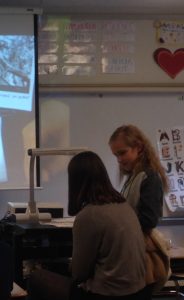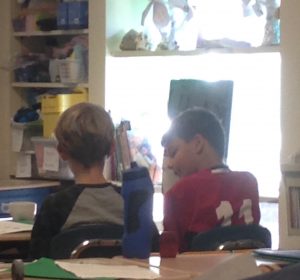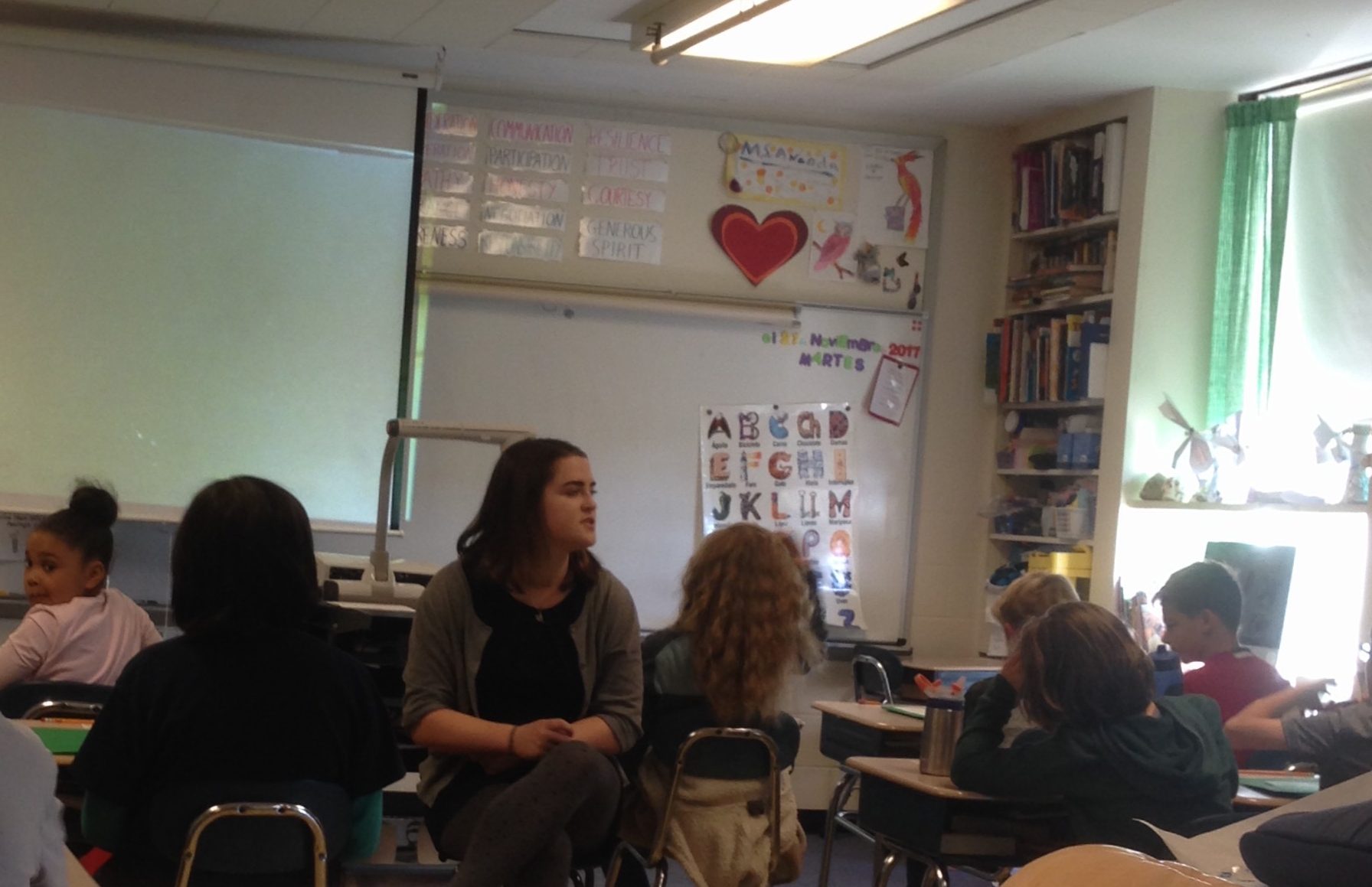Smith College senior and student teacher in Tiphareth Ananda’s fourth grade, Hannah Searles spent her fall semester in the classrooms of the Campus School. In an interview excerpted below, she spoke of her experiences learning to teach, and teaching to learn, at SCCS.
“What do plants need?” Hannah Searles asked while sitting in the middle of Ms. Ananda’s classroom, eye-level with her students. It was the start of her lesson on plant adaptations, and students were full of ideas. “They need space to grow!” one student shared while leafing through his notes– speaking, unwittingly, of the student experience as much as of plants on the rain forest floor.
Space to grow is what student teachers find when they enter the classrooms of mentor teachers at SCCS. It is also what they seek to create: places in which their students can take risks, share “half-formed thoughts,” and build a community of respect. The latter is at the heart of student teacher orientation: How do you build community in a classroom? Hannah was asked in late-August, when all she knew of her students were their names scribbled across folders. How does the physical setup of a classroom define a learning environment? What message does the construction of a classroom send to students and teachers?
As her semester at the Campus School draws to a close and she readies herself for second graders at Jackson Street Elementary School, Hannah turns to questions of teaching with refined energy and insight. She shares that insight below, recalling her journeys of learning, researching, and teaching in the Campus School community.

Q&A
- What are your responsibilities in Ms. Ananda’s class?
“Between the two [student teachers], we each do at least one morning meeting a week… I’ll [write] the morning message, [go] over the schedule. We play a game or do an activity a lot of times, which is fun. I tend to teach at least one full lesson a week, and I also do a decent amount of [individual] or small group work with kids. I do a lot of walking around the room, answering questions; the nice thing about having so many adults in the room is that it makes it possible for us to do a lot of that individual work… We can have writing conferences in a day, or in a period, because, between the three of us, we can pretty much hit everybody in a day. I’m also doing some grading; assessment is one of the skills that I’m working on strengthening. I have newfound respect for my high school English teachers!”
- What is one challenge that you faced as a student teacher, and how did you overcome it?
“I’m working on challenging perfectionism and practicing being OK with not being perfect, not getting it right 100% of the time, and remembering that this is a learning process for me… because, instinctually, you want to go in there and do a perfect lesson every time, but if I did it perfectly every time there would be no point in being a student teacher, and there are some things that just come with experience and practice… I’m definitely working on that growth mindset. [And learning that] there’s always an opportunity to back and challenge [students’] thinking, even if one unit block didn’t go exactly as planned. [I’m] learning to be flexible.”
- What is your process when planning lessons?
“I have a template for my lesson plans that [professor and Smith alumna Gina Wyman] gave to me, which… allows [me] to pull out what frameworks [I] want to use. I use Common Core primarily. [I] figure out what [my] learning objectives are… [and] that’s something I’ve really been working on this semester, taking big, broad, conceptual idea[s] and figuring out what we want [students] to do [to investigate them]. [I also make] sure [that I’m] pacing [my] lesson in an appropriate manner. [I] think about the launch, then the actual investigation, [then] assessment. We do a lot of informal assessment [and] check-ins. We don’t do a lot of formal testing in fourth grade.
In my lesson plans, I [also] think a lot about differentiation—how [I can] support struggling learners, and what sorts of extension activities [I am] going to have for early finishers, because we have a wide range of people in our classroom and certain things are easier for some people, but then maybe [those same people] struggle in another area, so it varies a lot subject-to-subject, lesson-to-lesson. [I] try to anticipate what [students’] needs are going to be and also be on the ball and adapt to the situation.”
- What are you learning from Ms. Ananda and her teaching methods?
“[Ms. Ananda and I] have a weekly meeting every Thursday while the kids are in library, and we have an end-of-week check-in where we figure out what lessons I’m going to teach in the upcoming week, talk about anything that happened during the week, share some observations, and just have a brief, informal conversation… I think one of the things I’m picking up from her is classroom management techniques. She’s really good at the nonverbal, or very quiet cues. She has a calm presence, and she’s really adept at controlling the room without making a fuss. So, if a kid needs to be corrected or reminded to sit up, she can just silently go over and put a hand on them, or whisper under her breath [without making] a big production. That’s been really interesting, and I’ve noticed myself doing it, too. I [also] sit in on her conferences with kids to hear how she deals with conflict management, which is a huge part of being a classroom teacher— not every conflict is huge, and the fact that she is really calm is helpful in those situations. She definitely feels like an unbiased party and works really hard [at] listening to both sides of the story.
[Ms. Ananda] gives really constructive feedback on my lessons and lesson plans…. Her expectations have been made very clear, and it’s obvious that she’s had a lot of student teachers before, which makes me feel better, because she is very conscious of her role as a mentor. I think it will be interesting to see, when I’m with another teacher, if anything changes in the way that I teach my lessons, because I think that [I] unconsciously pick up a lot of the [techniques] of [my mentor] when [I] plan [my] lessons.
[When you’re a student teacher], you’re asking someone to commit a pretty significant chunk of time to helping you, as well as helping the twenty-odd kids in their class, so it’s definitely a big commitment, and I’m very grateful.”
- How does your coursework at Smith inform your approach to student teaching, and how do you manage the challenge of putting theory into practice?
“I’ve realized it’s way harder to put theory into practice… but I’m learning that so much [of educational theory] makes [inherent] sense. Like what we’ve been learning about having a responsive classroom, for instance, or even the idea that kids can be teachers too and that teachers can be learners as well– that reciprocal model… I really try to talk to the kids and figure out what their prior knowledge is and respect the fact that they’re people with agency that can make decisions that influence their own learning, and that they can really have an active role.
I try to be mindful, as I’m planning my lessons, of not talking at [the kids] too much, [so] I try to ask a lot of questions, really pull them in, give them time to do independent thinking and work and realize that it’s OK if they’re quiet. They’re still learning and doing a lot of thinking on their own. It’s that ‘gradual release of responsibility model’ which we’re talking a lot about this semester in both [Professors and Smith College alumnae] Susan Etheridge and Gina Wyman’s classes. I do try to actively model that, and I do notice when my mentor teacher does it too.
The other thing is really trying to build relationships with students. We read this really interesting case study book in Individual Differences Among Learnings, which is one of the licensure classes. I think it was called “Sammy and His Behavior Problems,” but it was basically a teacher telling [readers] about a particularly difficult child that she worked with and her process over the year of trying to build a relationship with that student, trying to work through some of [his] behavioral problems and come up with solutions that engaged him [and] that also worked for everyone [in the class]. It was a really inspirational read… and it was cool to see an example of somebody really putting that into practice. She did a lot of responsive classroom work, which I think a lot of people in the Campus School use, and even the morning meeting is part of that. [It] sets up the community of learners, which is also a theory or idea that we talk a lot about in the education department: How do you build a community? How do you get kids to trust one another? How do you get them to trust you?
Those are some of the areas of theory that I’m really working to put into practice: 1) Gradual release of responsibility 2) Reciprocal teaching 3) Community building.
- Thinking about the Campus School as a lab school, what are some intersections between your own or others’ research and the SCCS community? In what ways have you noticed the presence of research in praxis?
“The Campus School is really unique in that we have people just observing in our classroom sometimes… the kids look at them a little funny at first, but then they just ignore them and really do act as their real selves, very naturalistic. I like that the environment feels really open; it supports the idea that learning is an ongoing process, even as a teacher. We had a teacher from Jackson Street [Elementary School] come in on their day off to observe us, just to see how another fourth grade classroom [works].
I love hearing about the other student teachers’ classrooms and routines. There’s a big emphasis on collaboration and learning as an ongoing process. I did a bunch of pre-practicum hours at the Campus School [and] a lot of observations, [and] I see a lot of Smith students tutoring.
This summer, I was doing research, not at the Campus School, but at Fort Hill, which is the Smith Day School. That was interesting because that is also set up as a lab preschool. They have a special room for researchers. [The kids] are more used to the fact that there are a lot of studies that go on… We’re in the process of developing a language screening tool for early intervention purposes.
[The lab school model] is a useful way to tie the [local] community into the Smith community as well—my kids know that I go to Smith, they know that I live on campus. A lot of my kids have parents who work here or are students here themselves, which is cool… I think the lab school aspect helps the kids feel connected to Smith. Often they’re like ‘wait, you’re a student too? You take classes?’ and I’m like ‘yeah, I’m a student teacher, I’m learning how to do this,’ which they think is really cool.
It’s really nice how [SCCS] feels like a space for innovation where you can try new things… you have some free reign to try out progressive [techniques]. We use the Common Core for certain things, but you have a lot of freedom, and I think that’s really beneficial. There are frameworks to guide you and general things that we talk about [as a community], but it definitely feels like a place where there’s a lot of room to push the boundaries and see what you can do.”

Hannah will graduate from Smith College in May, 2018, with degrees in Education and Psychology, as well as her elementary teaching license. She hopes to have her own elementary classroom for a few years before returning to graduate school for education or educational psychology.

Comments are closed, but trackbacks and pingbacks are open.